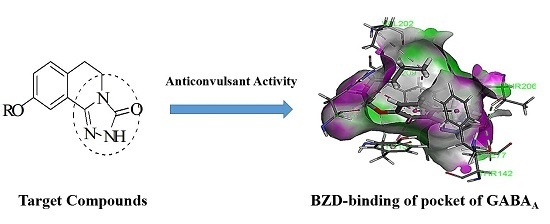Synthesis and Pharmacological Evaluation of New 3,4-Dihydroisoquinolin Derivatives Containing Heterocycle as Potential Anticonvulsant Agents
Abstract
:1. Introduction
2. Results and Discussion
2.1. Chemistry
2.2. Pharmacology
2.3. Docking Study
3. Experimental Section
3.1. Chemistry
3.1.1. Synthesis of 7-Methoxy-3,4-dihydroisoquinolin-1(2H)-one (1)
3.1.2. Synthesis of 7-Methoxy-3,4-dihydroisoquinoline-1(2H)-thione (2)
3.1.3. Synthesis of 9-Methoxy-5,6-dihydro-[1,2,4]triazolo[3,4-a]isoquinoline (4a)
3.1.4. Synthesis of 5,6-Dihydro-[1,2,4]triazolo[3,4-a]isoquinolin-9-ol (4b)
3.1.5. Synthesis of 9-Alkoxy-5,6-dihydro-[1,2,4]triazolo[3,4-a]isoquinoline (4c–t)
3.1.6. Synthesis of 7-Alkoxy-3,4-dihydroisoquinolin-1(2H)-one (6a–e)
3.1.7. Synthesis of 7-Alkoxy-3,4-dihydroisoquinolin-1(2H)-thione (7a–e)
3.1.8. Synthesis of 9-Alkoxy-5,6-dihydro-[1,2,4]triazolo[3,4-a]isoquinolin-3(2H)-one (9a–e)
3.2. Pharmacology
3.2.1. Maximal Electroshock Seizure
3.2.2. Neurotoxicity (NT) Screening
3.2.3. sc-PTZ-Induced Seizures
3.3. Molecular Modeling
4. Conclusions
Acknowledgments
Author Contributions
Conflicts of Interest
References
- Blume, W.T.; Lüders, H.O.; Mizrahi, E.; Tassinari, C.; van Emde Boas, W.; Engel, J., Jr. Glossary of descriptive terminology for ictal semiology: Report of the ILAE task force on classification and terminology. Epilepsia 2001, 42, 1212–1218. [Google Scholar] [CrossRef] [PubMed]
- Megiddo, I.; Colson, A.; Chisholm, D.; Dua, T.; Nandi, A.; Laxminarayan, R. Health and economic benefits of public financing of epilepsy treatment in India: An agent-based simulation model. Epilepsia 2016, 57, 464–474. [Google Scholar] [CrossRef] [PubMed] [Green Version]
- El-Helby, A.G.A.; Ayyad, R.R.; Sakr, H.M.; Abdelrahim, A.S.; El-Adl, K.; Sherbiny, F.S.; Eissa, I.H.; Khalifa, M.M. Design, synthesis, molecular modeling and biological evaluation of novel 2,3-dihydrophthalazine-1,4-dione derivatives as potential anticonvulsant agents. J. Mol. Struct. 2017, 1130, 333–351. [Google Scholar] [CrossRef]
- Sillanpaa, M.; Lastunen, S.; Helenius, H.; Schmidt, D. Regional differences and secular trends in the incidence of epilepsy in Finland: A nationwide 23-year registry study. Epilepsia 2011, 52, 1857–1867. [Google Scholar] [CrossRef] [PubMed]
- Curia, G.; Lucchi, C.; Vinet, J.; Gualtieri, F.; Marinelli, C.; Torsello, A.; Costantino, L.; Biagini, G. Pathophysiogenesis of mesial temporal lobe epilepsy: Is prevention of damage antiepileptogenic? Curr. Med. Chem. 2014, 21, 663–688. [Google Scholar] [CrossRef] [PubMed]
- Nelson, L.P.; Savelli-Castillo, I. New antiepileptic agents. Pediatr. Dent. 2004, 26, 58–62. [Google Scholar] [PubMed]
- Xie, Z.F.; Chai, K.Y.; Piao, H.R.; Kwak, K.C.; Quan, Z.S. Synthesis and anticonvulsant activity of 7-alkoxyl-4,5-dihydro-[1,2,4]triazolo[4,3-a]quinolines. Bioorg. Med. Chem. Lett. 2005, 15, 4803–4805. [Google Scholar] [CrossRef] [PubMed]
- Jin, H.G.; Sun, X.Y.; Chai, K.Y.; Piao, H.R.; Quan, Z.S. Anticonvulsant and toxicity evaluation of some 7-alkoxy-4,5-dihydro-[1,2,4]triazolo[4,3-a]quinoline-1(2H)-ones. Bioorg. Med. Chem. 2006, 14, 6868–6873. [Google Scholar] [CrossRef] [PubMed]
- Ferlin, M.G.; Chiarelotto, G.; Basadonna, O.; Gia, O.; Mobilio, S.; Baccichetti, F.; Carlassare, F. 1H-pyrrolo[2,3-f]quinoline and isoquinoline derivatives: Synthesis and antiproliferative activity. Farmaco 1989, 44, 1141–1155. [Google Scholar] [PubMed]
- Jen, T.; Dienel, B.; Dowalo, F.; van Hoeven, H.; Loev, B. Amidines. 5. Synthesis of pyrrolo [2,3-b]isoquinoline, imidazo[1,2-b]isoquinoline, pyrrolo[2,1-b]quinazoline, and 1,3-thiazine[2,3-b]quinazoline derivatives and related heterocycles as potential antihypertensive agents. J. Med. Chem. 1973, 16, 633–637. [Google Scholar] [CrossRef] [PubMed]
- Sugimoto, N.; Kugita, H. Studies on the syntheses of hydrogenated quinolines and isoquinolines as analgesics, XV. Synthesis of 3-hydroxy-N-methyl-7-aza-des-N-morphinan (9-hydroxy-3-methyl-5,10b-trimethylene-1,2,3,4,4a,4,6,10b-octahydrobenzo(f)isoquinoline. Chem. Pharm. Bull. 1958, 6, 429–433. [Google Scholar] [CrossRef] [PubMed]
- Zajdel, P.; Marciniec, K.; Maślankiewicz, A.; Satała, G.; Duszyńska, B.; Bojarski, A.J.; Partyka, A.; Jastrzębska-Więsek, M.; Wróbel, D.; Wesołowska, A.; et al. Quinoline- and isoquinoline-sulfonamide derivatives of LCAP as potent CNS multi-receptor-5-HT1A/5-HT2A/5-HT7 and D2/D3/D4-agents: The synthesis and pharmacological evaluation. Bioorg. Med. Chem. 2012, 20, 1545–1556. [Google Scholar] [CrossRef] [PubMed]
- Zhou, D.; Gross, J.L.; Adedoyin, A.B.; Aschmies, S.B.; Brennan, J.; Bowlby, M.; Di, L.; Kubek, K.; Platt, B.J.; Wang, Z.; et al. 2-(Pyrrolidin-1-yl)ethyl-3,4-dihydroisoquinolin-1(2H)-one derivatives as potent and selective histamine-3 receptor antagonists. J. Med. Chem. 2012, 55, 2452–2468. [Google Scholar] [CrossRef] [PubMed]
- Kovács, D.; Wölfling, J.; Szabó, N.; Szécsi, M.; Minorics, R.; Zupkó, I.; Frank, É. Efficient access to novel androsteno-17-[1′,3′,4′]-oxadiazoles and 17β-[1′,3′,4′]-thiadiazoles via N-substituted hydrazone and N,N′-disubstituted hydrazine intermediates, and their pharmacological evaluation in vitro. Eur. J. Med. Chem. 2015, 98, 13–29. [Google Scholar]
- Wang, S.B.; Piao, G.C.; Zhang, H.J.; Quan, Z.S. Synthesis of 5-alkoxythieno[2,3-e][1,2,4]triazolo[4,3-c]pyrimidine derivatives and evaluation of their anticonvulsant activities. Molecules 2015, 20, 6827–6843. [Google Scholar] [CrossRef] [PubMed]
- Zhang, H.J.; Jin, P.; Wang, S.B.; Li, F.N.; Guan, L.P.; Quan, Z.S. Synthesis and Anticonvulsant Activity Evaluation of 4-Phenyl-[1,2,4]triazolo[4,3-a]quinazolin-5(4H)-one and Its Derivatives. Arch. Pharm. 2015, 348, 564–574. [Google Scholar] [CrossRef] [PubMed]
- Zhang, H.J.; Wang, S.B.; Quan, Z.S. Synthesis and antidepressant activities of 4-(substituted-phenyl)tetrazolo[1,5-a]quinazolin-5(4H)-ones and their derivatives. Mol. Divers. 2015, 19, 817–828. [Google Scholar] [CrossRef] [PubMed]
- Krall, R.L.; Penry, J.K.; White, B.G.; Kupferberg, H.J.; Swinyard, E.A. Antiepileptic drug development: II. Anticonvulsant drug screening. Epilepsia 1978, 19, 409–428. [Google Scholar] [CrossRef] [PubMed]
- Porter, R.J.; Cereghino, J.J.; Gladding, G.D.; Hessie, B.J.; Kupferberg, H.J.; Scoville, B.; White, B.G. Antiepileptic Drug Development Program. Clevel. Clin. Q. 1984, 51, 293–305. [Google Scholar] [CrossRef]
- Sun, X.Y.; Jin, Y.Z.; Li, F.N.; Li, G.; Chai, K.Y.; Quan, Z.S. Synthesis of 8-alkoxy-4,5-dihydro-[1,2,4]triazole[4,3-a]quinoline-1-ones and evaluation of their anticonvulsant properties. Arch. Pharm. Res. 2006, 29, 1080–1085. [Google Scholar] [CrossRef] [PubMed]
- Okada, R.; Negishi, N.; Nagaya, H. The role of the nigrotegmental GABAergic pathway in the propagation of pentylenetetrazol-induced seizures. Brain Res. 1989, 480, 383–387. [Google Scholar] [CrossRef]
- Treiman, D.M.; Walker, M.C. Treatment of seizure emergencies: Convulsive and non-convulsive status epilepticus. Epilepsy Res. 2006, 68, S77–S82. [Google Scholar] [CrossRef] [PubMed]
- Mohammadi-Khanaposhtani, M.; Shabani, M.; Faizi, M.; Aghaei, I.; Jahani, R.; Sharafi, Z.; Shamsaei Zafarghandi, N.; Mahdavi, M.; Akbarzadeh, T.; Emami, S.; et al. Design, synthesis, pharmacological evaluation, and docking study of new acridone-based 1,2,4-oxadiazoles as potential anticonvulsant agents. Eur. J. Med. Chem. 2016, 112, 91–98. [Google Scholar] [CrossRef] [PubMed]
- Lankau, H.J.; Unverferth, K.; Grunwald, C.; Hartenhauer, H.; Heinecke, K.; Bernöster, K.; Dost, R.; Egerland, U.; Rundfeldt, C. New GABA-modulating 1,2,4-oxadiazole derivatives and their anticonvulsant activity. Eur. J. Med. Chem. 2007, 42, 873–879. [Google Scholar] [CrossRef] [PubMed]
- Mohamed-Kamal, I.; Khaled, E.A.; Ahmed, A.A.K. Design, synthesis, molecular docking and anticonvulsant evaluation of novel 6-iodo-2-phenyl-3-substituted-quinazolin-4(3H)-ones. Bull. Fac. Pharm. Cairo Univ. 2015, 53, 101–116. [Google Scholar]
- Sullivan, S.K.; Petroski, R.E.; Verge, G.; Gross, R.S.; Foster, A.C.; Grigoriadis, D.E. Characterization of the interaction of indiplon, a novel pyrazolopyrimidine sedative-hypnotic, with the GABAA receptor. J. Pharmacol. Exp. Ther. 2004, 311, 537–546. [Google Scholar] [CrossRef] [PubMed]
- Döble, A.; Canton, T.; Malgouris, C.; Stutzmann, J.; Piot, O.; Bardone, M.; Pauchet, C.; Blanchard, J. The mechanism of action of zopiclone. Eur. Psychiatry 1995, 10, 117S–128S. [Google Scholar] [CrossRef]
- Wegner, F.; Deuther-Conrad, W.; Scheunemann, M.; Brust, P.; Fischer, S.; Hiller, A.; Diekers, M.; Strecker, K.; Wohlfarth, K.; Allgaier, C.; et al. GABAA receptor pharmacology of fluorinated derivatives of the novel sedative-hypnotic pyrazolopyrimidine indiplon. Eur. J. Pharmacol. 2008, 580, 1–11. [Google Scholar] [CrossRef] [PubMed]
- Di Mola, A.; Gatta, E.; Petronzi, C.; Cupello, A.; de Caprariis, P.; Robello, M.; Massa, A.; Filosa, R. Synthesis and pharmacological evaluation of functionalized isoindolinones on GABA-activated chloride currents in rat cerebellum granule cells in culture. Bioorg. Med. Chem. Lett. 2016, 26, 5284–5289. [Google Scholar] [CrossRef] [PubMed]
- Ertl, P.; Rohde, B.; Selzer, P. Fast calculation of molecular polar surface area as a sum of fragment-based contributions and its application to the prediction of drug transport properties. J. Med. Chem. 2000, 43, 3714–3717. [Google Scholar] [CrossRef] [PubMed]
- Zhao, Y.H.; Abraham, M.H.; Le, J.; Hersey, A.; Luscombe, C.N.; Beck, G.; Sherborne, B.; Cooper, I. Rate-limited steps of human oral absorption and QSAR studies. Pharm. Res. 2002, 19, 1446–1457. [Google Scholar] [CrossRef] [PubMed]
- Geurts, M.; Poupaert, J.H.; Scriba, G.K.; Lambert, D.M. N-(benzyloxycarbonyl)glycine esters and amides as new anticonvulsants. J. Med. Chem. 1998, 41, 24–30. [Google Scholar] [CrossRef] [PubMed]
- Richter, L.; de Graaf, C.; Sieghart, W.; Varagic, Z.; Mörzinger, M.; de Esch, I.J.; Ecker, G.F.; Ernst, M. Diazepam-bound GABAA receptor models identify new benzodiazepine binding-site ligands. Nat. Chem. Biol. 2012, 8, 455–464. [Google Scholar] [CrossRef] [PubMed]
- Sample Availability: Samples of all the target compounds are available from the authors.
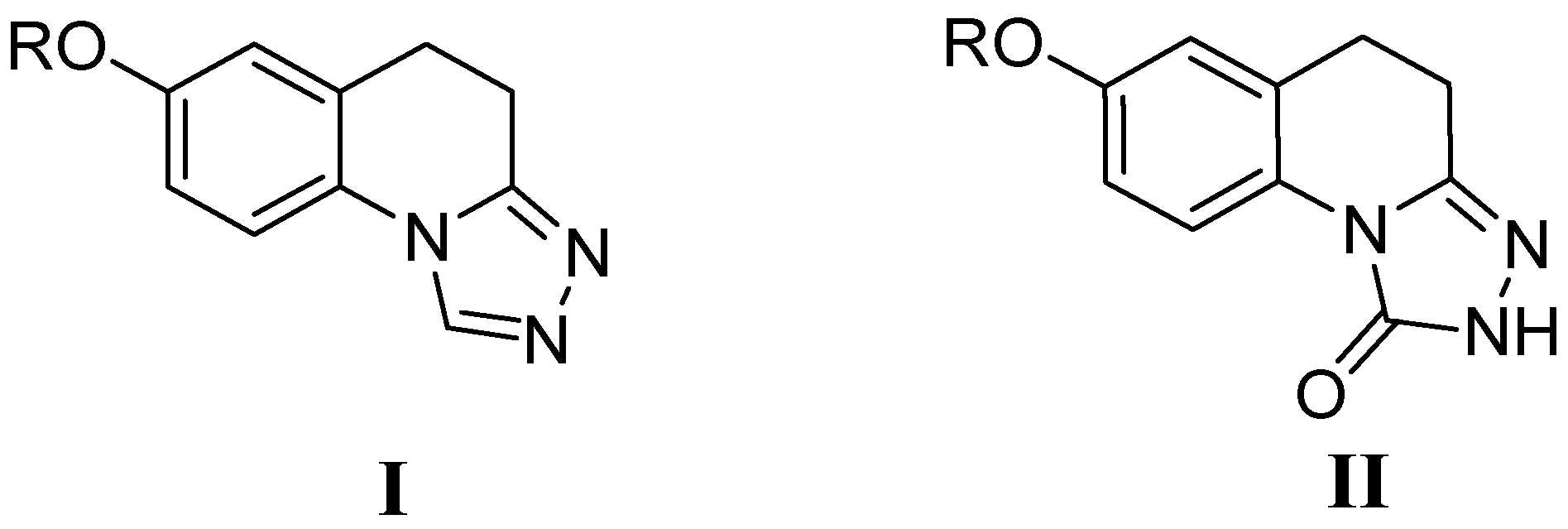
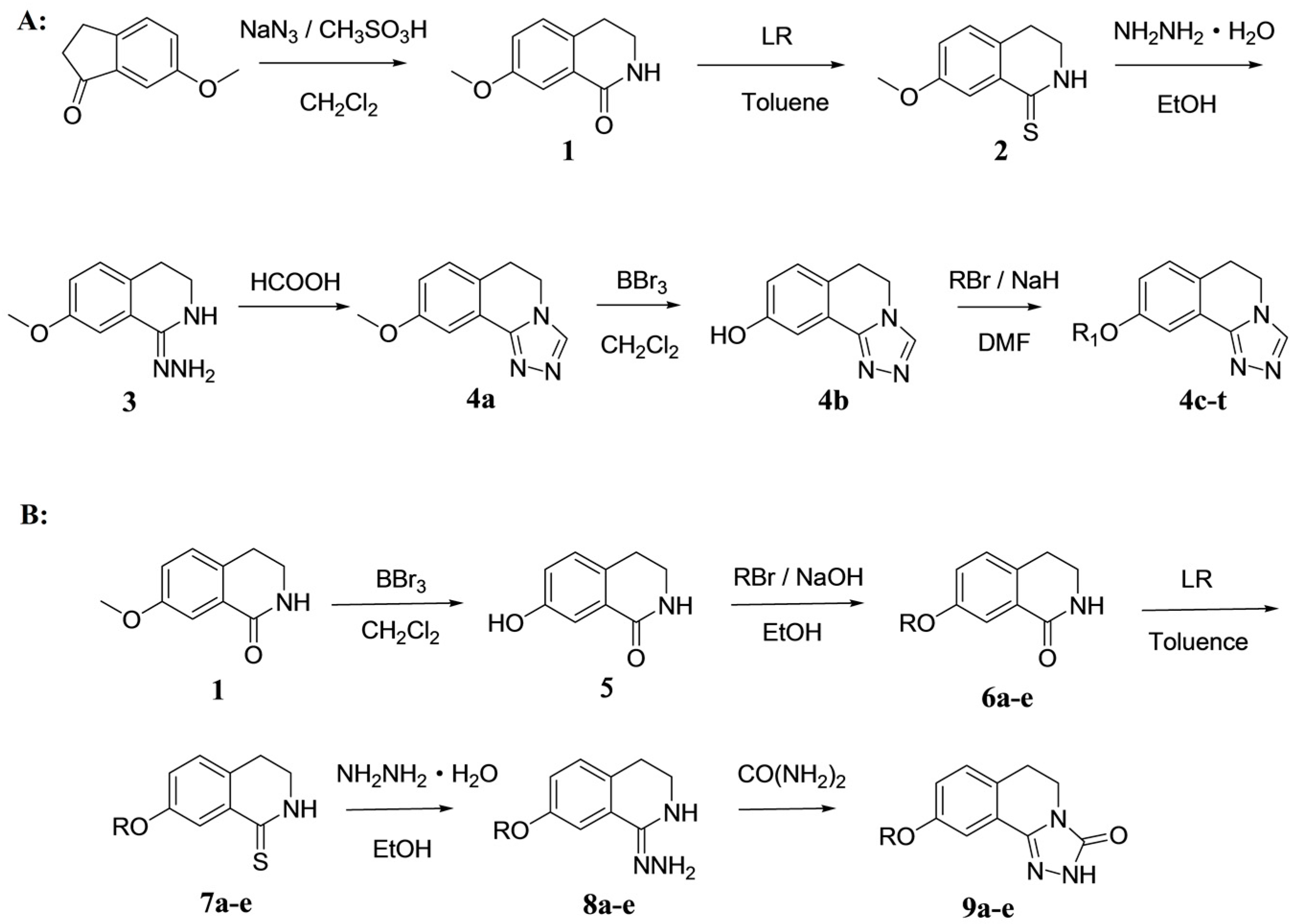
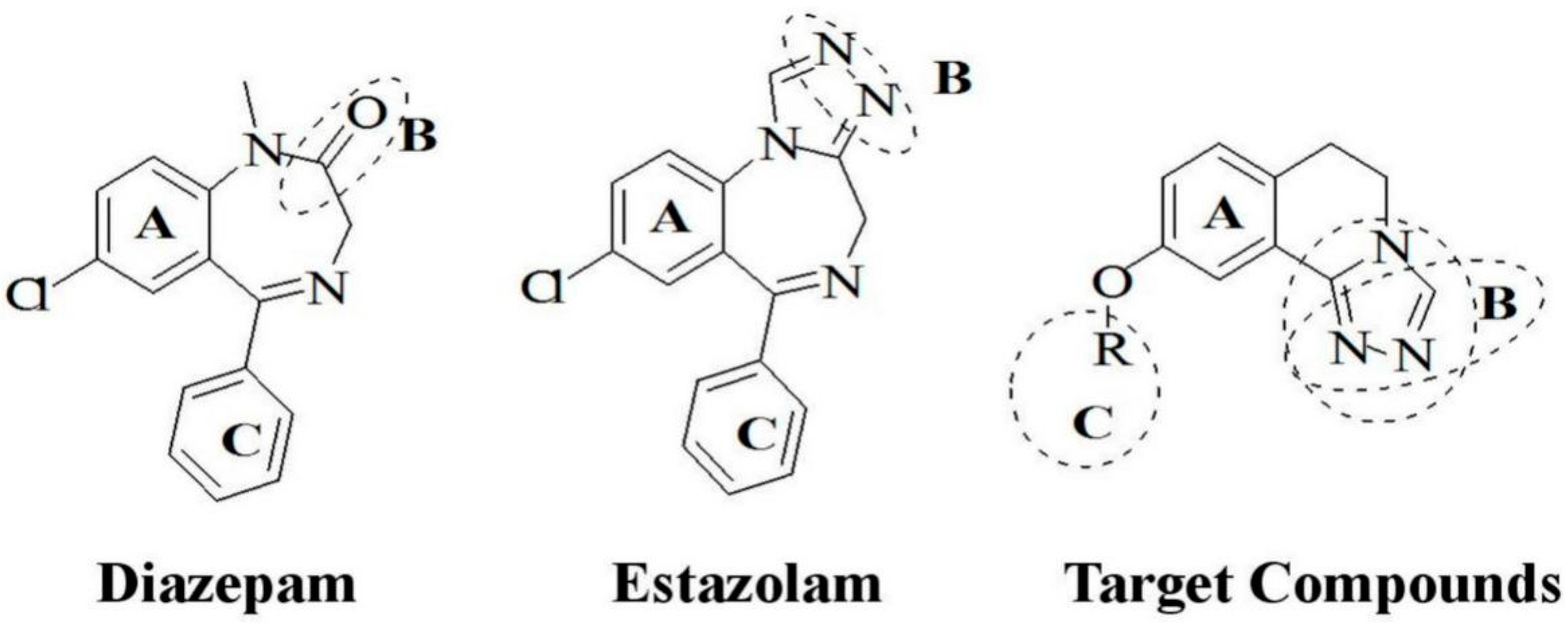
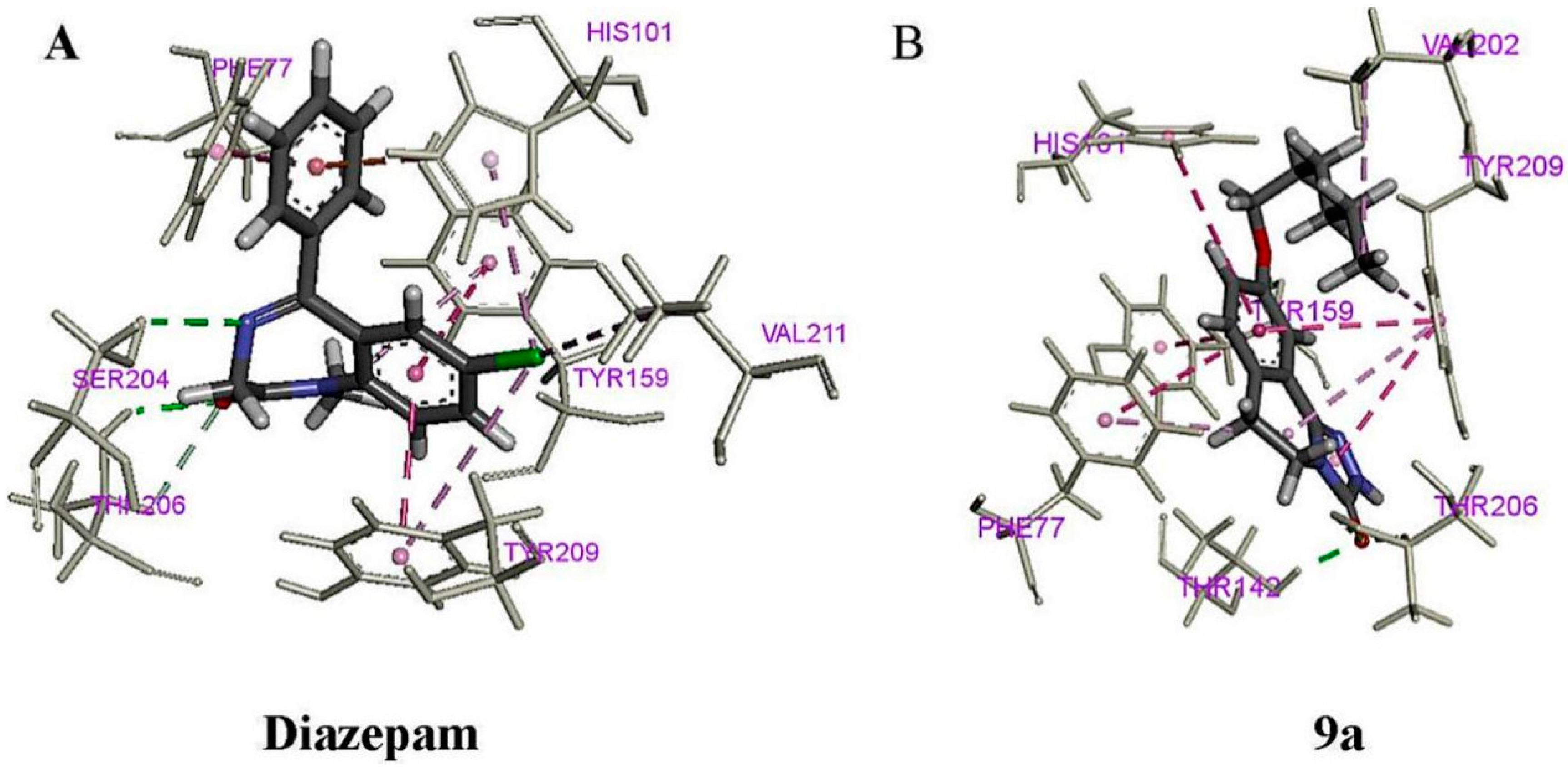
| Compound | R | MES a | Toxicity | ||
|---|---|---|---|---|---|
| 100 | 30 | 100 | 30 | ||
| 4a | –CH3 | 0/3 | - b | 0/3 | - |
| 4b | –H | 0/3 | - | 0/3 | - |
| 4c | n-C5H11 | 2/3 | 0/3 | 0/3 | - |
| 4d | n-C6H13 | 3/3 | 0/3 | 0/3 | - |
| 4e | n-C7H15 | 3/3 | 1/3 | 0/3 | - |
| 4f | n-C8H17 | 1/3 | - | 0/3 | - |
| 4g | n-C9H19 | 0/3 | - | 0/3 | - |
| 4h | n-C10H21 | 0/3 | - | 0/3 | - |
| 4i | –CH2C6H5 | 2/3 | 0/3 | 0/3 | - |
| 4j | –CH2C6H4 (o-F) | 2/3 | 0/3 | 1/3 | - |
| 4k | –CH2C6H4 (m-F) | 2/3 | 0/3 | 0/3 | - |
| 4l | –CH2C6H4 (p-F) | 1/3 | - | 0/3 | - |
| 4m | –CH2C6H4 (o-Cl) | 2/3 | 0/3 | 0/3 | - |
| 4n | –CH2C6H4 (m-Cl) | 2/3 | 0/3 | 1/3 | - |
| 4o | –CH2C6H4 (p-Cl) | 0/3 | 0/3 | 1/3 | - |
| 4p | –CH2C6H3 (2,4-2Cl) | 0/3 | 0/3 | 0/3 | - |
| 4q | –CH2C6H3 (2,6-2Cl) | 2/3 | - | 2/3 | 0/3 |
| 4r | –CH2C6H4 (m-CF3) | 0/3 | - | 0/3 | - |
| 4s | –CH2C6H4 (p-CH3) | 1/3 | - | 0/3 | - |
| 4t | –CH2C6H4 (o-CN) | 0/3 | - | 0/3 | - |
| 9a | n-C6H13 | 3/3 | 1/3 | 0/3 | - |
| 9b | n-C7H15 | 1/3 | - | 0/3 | - |
| 9c | n-C8H17 | 0/3 | - | 0/3 | - |
| 9d | –CH2C6H5 | 2/3 | 1/3 | 0/3 | - |
| 9e | –CH2C6H4 (p-Cl) | 0/3 | - | 0/3 | - |
| Compound | ED50 a (MES, mg/kg) | TD50 b (mg/kg) | PI c |
|---|---|---|---|
| 4e | 48.19 (33.11–70.15) d | 163.26 (142.88–186.64) | 3.4 |
| 9a | 63.31 (46.17–86.82) | >500 | >7.9 |
| 9d | 68.16 (53.74–86.44) | 378.62 (322.56–444.00) | 5.6 |
| Valproate | 272 (247–338) | 426 (369–450) | 1.6 |
| Carbamazepine | 11.8 (8.5–16.4) | 71.6 (45.9–153) | 8.1 |
| Compound | Doses (mg/kg) | Clonic Seizures (%) a | Tonic Seizures (%) | Lethality (%) |
|---|---|---|---|---|
| DMSO | - | 100 | 100 | 90 |
| 9a | 100 | 100 | 10 | 60 |
| Carbamazepine | 50 | 100 | 0 | 0 |
| Score Sorting | Compounds | LibDockScore |
|---|---|---|
| 1 | III | 127.219 |
| 2 | IV | 120.181 |
| 3 | 9a | 118.06 |
| 4 | 9d | 118.036 |
| Compound | MW a (< 500) | HBA b (< 10) | HBD c (≤ 5) | TPSA d | %ABS e |
|---|---|---|---|---|---|
| 9a | 287.36 | 5 | 1 | 59.92 | 88.33 |
© 2016 by the authors. Licensee MDPI, Basel, Switzerland. This article is an open access article distributed under the terms and conditions of the Creative Commons Attribution (CC-BY) license ( http://creativecommons.org/licenses/by/4.0/).
Share and Cite
Zhang, H.-J.; Shen, Q.-K.; Jin, C.-M.; Quan, Z.-S. Synthesis and Pharmacological Evaluation of New 3,4-Dihydroisoquinolin Derivatives Containing Heterocycle as Potential Anticonvulsant Agents. Molecules 2016, 21, 1635. https://doi.org/10.3390/molecules21121635
Zhang H-J, Shen Q-K, Jin C-M, Quan Z-S. Synthesis and Pharmacological Evaluation of New 3,4-Dihydroisoquinolin Derivatives Containing Heterocycle as Potential Anticonvulsant Agents. Molecules. 2016; 21(12):1635. https://doi.org/10.3390/molecules21121635
Chicago/Turabian StyleZhang, Hong-Jian, Qing-Kun Shen, Chun-Mei Jin, and Zhe-Shan Quan. 2016. "Synthesis and Pharmacological Evaluation of New 3,4-Dihydroisoquinolin Derivatives Containing Heterocycle as Potential Anticonvulsant Agents" Molecules 21, no. 12: 1635. https://doi.org/10.3390/molecules21121635




